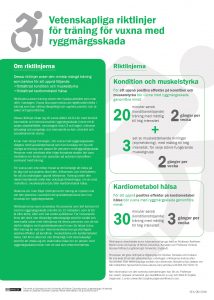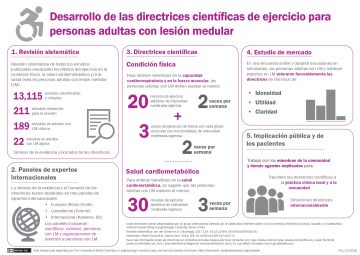SCI Action International is a collection of international resources designed to promote the scientific exercise guidelines for adults with SCI.
These resources include direct language translations of the original scientific guidelines as well as translations of the scientific guidelines into clinical and community practice guidelines.
Signup
To receive notifications when new resources are added to SCI Action International, please enter your email address.
The Guidelines were created by an international group of 29 researchers, clinicians, community organizations, knowledge translation specialists and people with spinal cord injury (SCI) to inform people with SCI how much exercise is necessary for important fitness and health benefits.
The scientific guidelines were based on gold-standard practices that included reviewing 13,115 published research studies that tested the effects of physical activity on fitness and health among adults with SCI. The 29-member panel reviewed the evidence to agree on the effective frequency, intensity and duration of exercise. Final guidelines were produced based on further market research with adults with SCI and clinicians who assessed the guidelines for usefulness, appropriateness and clarity.
The Scientific Exercise Guidelines for Adults with Spinal Cord Injury and corresponding Infographic Development of Scientific Exercise Guidelines for Adults with Spinal Cord Injury which describes the process of developing the guidelines, are available in multiple languages and can also be found on the National Centre for Sport and Exercise Medicine (NCSEM): Working for Health & Wellbeing, East Midlands website.

Collaborators involved in translating the guidelines into Japanese include:
Dr Yukio Mikami MD, Associate Professor, Department of Rehabilitation Medicine, Wakayama Medical University
Dr Hiroshi Shinohara, Associate Professor, Department of Physical Therapy, Takarazuka University of Medical and Health Care
Dr Takafumi Sakai, Associate Professor, Department of Physical Therapy, Takarazuka University of Medical and Health Care
Professor Futoshi Obata, Professor, Department of Physical Therapy, Takarazuka University of Medical and Health Care

Collaborators involved in translating the guidelines into South Korean include:
Professor Seung Hyun Yoon MD, Department of Physical Medicine and Rehabilitation Ajou University School of Medicine
Dr Kun Ho Lee, Lecturer and Researcher, Department of Prescription and Rehabilitation of Exercise, Dankook University

Collaborators involved in translating the guidelines into Persian include:
Mehdi Ahmadian, Ph.D. Candidate, University of British Columbia, School of Kinesiology
Dr Valiollah Dabidi Roshan, University of Mazandaran.

Collaborators involved in translating the guidelines into Spanish include:
Dr Joan Úbeda-Colomer, Postdoctoral Fellow at the University of British Columbia
Lluisa Montesinos-Magraner, Coordinator of the Spinal Cord Injury Unit at the Vall d’Hebron Hospital
Dr Javier Monforte, Postdoctoral Fellow at Durham University
Dr Luis-Millan Gonzalez, Associate Professor at the University of Valencia

Collaborators involved in translating the guidelines into Swedish include:
Professor Jan Lexell, Consultant in Rehabilitation Medicine and Medical Director
Dr Sophie Jorgensen, PhD, Resident in Rehabilitation Medicine

Collaborators involved in translating the guidelines into Thai include:
Dr Chayaporn Chotiyarnwong MD, Clinical instructor, Department of Rehabilitation Medicine, Faculty of Medicine Siriraj Hospital, Mahidol University
Dr Napatpaphan Kanjanapanang MD, Department of Rehabilitation Medicine, Faculty of Medicine Siriraj Hospital, Mahidol University
Dr Pannika Prachgosin MD, Department of Rehabilitation Medicine, Faculty of Medicine Siriraj Hospital, Mahidol University
Dr Phairin Laohasinnarong MD, Department of Rehabilitation Medicine, Faculty of Medicine Siriraj Hospital, Mahidol University
Dr Siraprapa Limprasert MD, Department of Rehabilitation Medicine, Faculty of Medicine Siriraj Hospital, Mahidol University

Collaborators involved in translating the guidelines into Italian include:
Professor Marco Bernardi, Professor of Exercise and Sport Sciences

Collaborators involved in translating the guidelines into German include:
Dr Alexandrar Rauch, Consultant WHO Disability and Rehabilitation Programme

Collaborators involved in translating the guidelines into Dutch include:
Dr Sonja de Groot, Assistant Professor, Senior Researcher Reade
Dr Jan van der Scheer, Senior Research Associate

Collaborators involved in translating the guidelines into Indonesian include:
Dr Damayanti Tinduh MD, Physiatrist, Department of Physical Medicine and Rehabilitation, Faculty of Medicine, Universitas Airlangga Dr Soetomo General Academic Hospital
Dr Indrayuni Lukitra Wardhani MD, Physiatrist, Department of Physical Medicine and Rehabilitation, Faculty of Medicine, Universitas Airlangga Dr Soetomo General Academic Hospital
Dr Martha Kurnia Kusumawardani MD, Physiatrist, Department of Physical Medicine and Rehabilitation, Faculty of Medicine, Universitas Airlangga Dr Soetomo General Academic Hospital
Dr Ditaruni Asrina Utami MD, Physiatrist, Department of Physical Medicine and Rehabilitation, Faculty of Medicine, Universitas Airlangga Dr Soetomo General Academic Hospital
Dr Inggar Narasinta MD, Department of Physical Medicine and Rehabilitation, Physiatrist, Department of Physical Medicine and Rehabilitation, Faculty of Medicine, Universitas Airlangga Dr Soetomo General Academic Hospital
Indonesian/Bahasa Indonesia (pdf, 96kb)

Collaborators involved in translating the guidelines into Greek include:
Arabic/عربي

Collaborators involved in translating the guidelines into Arabic include:
Ukrainian/Українська мова

Collaborators involved in translating the guidelines into Ukrainian include:
Brazilian/Portuguese/Brasileiro
Português

Collaborators involved in translating the guidelines into Brazilian/Portuguese include:
Dr Camila Quel de Oliveira, Senior Lecturer Physiotherapy, Graduate School of Health, Faculty of Health, University of Technology Sydney.
Dr Jocemar Ilha, Associate Professor Physiotherapy, Physiotherapy Department, Universidade do Estado de Santa Catarina
Norwegian

Infographic of the Development of the Guidelines in Various Languages
When the international expert panel developed The Scientific Exercise Guidelines for Adults with Spinal Cord Injury, panel members highlighted two key challenges to implementing the guidelines in community and clinical practice settings. First, panel members were concerned that it may be confusing to have two guidelines as people may not know which guideline to follow. Second, using the word “exercise” might limit people’s thinking about opportunities to be physically active (e.g., people might only think that they can ‘exercise’ in a gym).
Because these challenges could only be addressed by deviating from the scientific evidence, the panel recommended distinguishing between “scientific SCI exercise guidelines” and “community and clinical practice guidelines”.
The panel called for a community-engaged strategy to translate the scientific SCI exercise guidelines into guidelines that can be communicated to and used in community and clinical practice settings. By working with community stakeholders—that is, people who will actually use the guidelines in clinical and community settings—the scientific guidelines can be adapted to local contexts. This approach ensures that the guidelines take into account the types of equipment, activities, services and customs that are typical in the local settings where the guidelines will be implemented.
So far, community-engaged processes have been used to translate the scientific guidelines into community and clinical practice guidelines in Canada and the Netherlands.
Starting level
The starting level is the minimum level of activity needed to achieve fitness benefits.
Advanced level
The advanced level will give you additional fitness and health benefits, such as lowering your risk of developing Type 2 diabetes and heart disease.
Aerobic activities
Aerobic activities are physical activities that are done continuously and that increase your heart rate and breathing rate, such as wheeling, swimming, hand cycling or dancing.
Strength-training activities
Strength-training activities are activities that increase muscle strength, such as exercises using resistance bands, or lifting weights.
Moderate intensity activities
Moderate intensity activities require you to work somewhat hard, but you should feel like you can keep going for a long time. You should be able to talk during these activities, but not sing your favourite song.
Vigorous intensity activities
Vigorous intensity activities require you to work really hard, and you can only continue them for a short time before getting tired.








